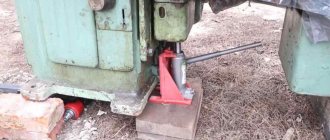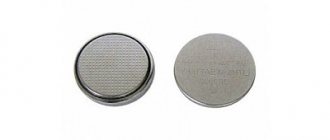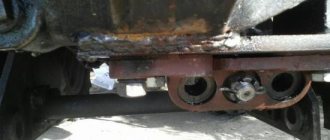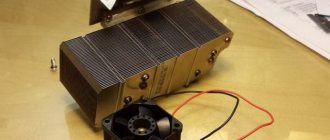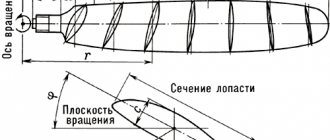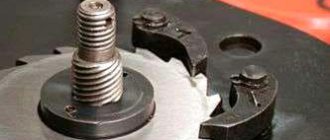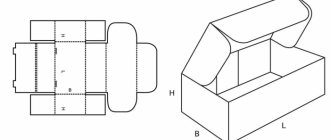When repairing the steering and chassis, almost every car owner is faced with a problem (tire rod ends), which is quite problematic to solve without a special tool.
The reason is the design features of the named elements: their fingers have a cone-shaped shape, with which they enter the mounting sockets; over time, the place of this entry becomes dirty, oily, rusty, making the connection of the surfaces too dense, almost uniform, that is, one that cannot be separated by simple physical force . You need an assistant - a ball joint remover - a tool that greatly simplifies pressing out.
It is not difficult to become its owner: to do this, you need to go to the nearest auto store and purchase it there, or make a ball joint remover with your own hands using any of the methods presented below, which we have grouped depending on how the force is created in them.
- Screw pullers.
- Option No. 1 – screw expansion.
- Option No. 2 – screw L-shaped.
- Option No. 3 - a screw puller of ball joints made from a corner.
- Lever pullers.
- Wedge type puller.
- Puller directly for ball joints.
- Video.
Puller drawings. Repair equipment. Tool
This topic will provide drawings of pullers and devices for car repairs, as well as drawings of special tools.
The following drawings are currently available:
Drawing of the front suspension strut rod nut remover.
Drawing of a universal screw puller for steering rod pins.
Drawing of spring ties for front and rear suspensions.
Drawing of a puller for pressing out the silent block of the rear suspension shock absorber.
Drawing of a puller for pressing in the silent block of the rear suspension shock absorber.
Drawing of a wheel bearing puller for the front and rear wheels.
Drills for knocking out wheel bearings
Photo of drifts for knocking out a wheel bearing
Mandrels for pressing in wheel bearings
Photo of mandrels for pressing in the wheel bearing of the front and rear wheels of VAZ-2108, VAZ-2109, VAZ-21099, VAZ-2113, VAZ-2114, VAZ-2115. The photo also shows rings from old wheel bearings, they also help with pressing.
Drawing of a puller for replacing rubber-metal hinges of the rear beam.
Replacement of rubber-metal hinges of the rear beam
Photo of the puller
Drawing of a puller for replacing the silent blocks of the front suspension arm.
Photos of the puller
Puller for replacing silent blocks of the front suspension arm
Device for compressing brake cylinders.
The brake cylinder compressor is made from old brake pads. Everything seems to be visible in the photo.
Photo of a device for compressing brake cylinders.
Drawing of brake cylinder compression device
Source
DIY ball joint remover: instructions and materials
When repairing the chassis of any car, it becomes necessary to remove steering rods or ball joints. In both cases, their tip has a conical shape, which ensures optimal fit of the products in the socket. During operation, they become very compact, and if moisture gets between them, then corrosion forms at their joints. It makes it even more difficult to separate these parts.
To make repair work easier, a do-it-yourself ball joint remover would be an excellent option, which will greatly simplify the repair and help remove the tip with little effort.
Why is it needed?
How to make a steering wheel end remover with your own hands? This question arises among people who are faced with the need to use it. But not everyone knows why this tool is needed. Although, its use extends the service life of the steering. After all, in the absence of a puller, you have to use a hammer. By tapping the pull, you gradually pull it out of place. At the same time, vibration is formed, which negatively affects the steering rack. But not only this fact forces the use of pullers.
Tapping with a hammer is a rather long and exhausting task. While with a puller this can be done in a few minutes. This speeds up the work process significantly. Which will ultimately save you time and nerves.
Why do you need a ball joint remover?
Without it, it is difficult to dismantle and carry out repair work on the chassis of the car; a puller may also be needed to disassemble the steering joints . It can be used for ball joints of different diameters. When choosing its design, they rely on the technical characteristics of a particular car.
Theoretically, the dismantling of ball joints can be carried out with any available tool, using a sledgehammer or hammer, but such repairs are classified as “stressful”.
Article number and approximate price for original ball joints for VAZ 2107
On the VAZ 2107 car, upper and lower supports are structurally provided. If one of them fails, it is recommended to replace the set, but separate replacement is also possible. The original lower ball has an article number - 2101029040828. Its price is about 360-450 rubles.
The original upper part of the VAZ 2107 car comes with the article number 21010290419286. Its cost ranges from 420 to 570 rubles. The service life of ball joints is directly related to the quality of the road surface and the driving style of the car owner.
What does a puller look like?
There are three types of pullers :
They differ in appearance, but their operating principle is the same. The finger is twisted out of its seat using a hammer or by turning the nut . The puller is designed in such a way that it fills the space between the connected parts and after turning it you can hear a click, indicating that the connection has loosened and you can remove the ball joint from its seat.
The puller helps even a novice in auto repair work to dismantle it.
Which puller is better?
In the video you can see several options for ball pullers , among them the screw one , but only it must be made with high quality.
Its analogue in the form of a fork is universal, since it can be used not only for ball joints, it also helps when removing steering ends. However, its work can negatively affect the anthers.
There are difficult cases when you have to work with a puller and a hammer in pairs: first, the supports are pushed apart with a screw, and then you need to strike with a sledgehammer.
Video.
How to make a ball joint and steering wheel remover with your own hands. Simple and free. Good day to all!
In this article I would like to share with you a very good homemade product, namely a ball joint and steering wheel end remover. I don’t know if it will fit on other cars, but it will definitely fit on a VAZ!
Not long ago I changed the ball joint using the “old-fashioned” method using a hammer, I’ll tell you it’s not very convenient and fast. After looking on the Internet, I found how to make a puller easily and without cost; on the Internet I looked at prices from 500 rubles and above! This homemade product will take about 30-60 minutes if you have everything you need.
And we need:
- A pipe with an internal diameter of 45-50mm, and a thickness of at least 2 mm, more is possible!
- Two thick washers to fit the diameter of the pipe, or you can cut them out of thick metal.
- Bolt and nut, I used a 24mm wrench bolt, maybe smaller.
Step-by-step manufacturing instructions
The device for removing ball joints is quite complicated, but if you follow the step-by-step instructions, you can do it yourself:
The finished device is suitable for emergency and planned replacement of ball joints on Zhiguli and Lanos, as well as some brands of foreign manufacturers.
The manufactured puller is not universal and cannot be used for different components, but if you succeeded in doing it the first time, then subsequent versions will be much easier.
For 15 years I have been repairing various types of cars, including brands such as VAZ, UAZ, Chevrolet, Mazda, Kia and many others. Everything related to the gearbox, engine or chassis. You can write me your question below in the comments and I will try to answer it in detail.
Source
Article number and cost of good analogues of original VAZ 2107 ball joints from third-party manufacturers
The quality of original balls differs from batch to batch. It is possible to purchase both good support and outright rubbish. Therefore, many car owners doubt which one is better to install. They often refuse to buy the original in favor of products from third-party manufacturers. The best analogues of native balls are presented in the tables below.
Table - Good analogues of ball 2101029040828
| Manufacturer | vendor code | Approximate cost, ruble |
| TRW | JBJ250 | 520-600 |
| Lemforder | 3731501 | 590-710 |
| Delphi | TC204 | 370-450 |
| Monroe | L0704 | 440-530 |
| CTR | CBFI4 | 510-630 |
Table - Recommended alternative support options 21010290419286
| Manufacturer | vendor code | Approximate cost, ruble |
| Moog | LABJ0392 | 360-420 |
| Profit | 23010098 | 260-300 |
| Denckermann | D110135 | 250-315 |
| Lemforder | 37320 | 330-425 |
| Delphi | TC203 | 395-450 |
How to make a ball joint remover with your own hands
When carrying out repairs to the chassis and steering, there is almost always a need to remove ball joints or tie rod ends.
The peculiarity of these structural elements is that the support pin or tip has a conical shape, with which it fits into the seat.
During operation, the fit density increases so much that the surfaces of this joint practically stick to each other.
Additionally, moisture can get between the finger and the socket, causing pockets of corrosion that further seal the connection.
Therefore, to remove ball joints or tips, special pullers are used that allow you to press out the pin with minimal effort.
Features of using pullers
The main thing is to be able to properly handle any tool. Because, no matter how high-tech it is, its incorrect use will not only not facilitate the work process, but simply will not allow you to complete even the most basic procedure.
Note that before proceeding with the dismantling of the tie rod ends, it is necessary to clean the junction of the tie rod end pin and the steering knuckle from dirt, and then apply a penetrating lubricant. This will help make the pin removal process easier and avoid damage to nearby parts of the vehicle's steering system. This should be done several hours before carrying out repairs so that the lubricant completely penetrates the joint.
Tie rod end pullers are hand-made incredibly useful devices that not only facilitate the process of removing the pins, but also protect the steering rack from damage.
Types of pullers
The auto tools market offers a wide selection of such removable mechanisms, which can be divided into two types:
Screw pullers are considered universal and are suitable for working with almost any car.
The force in them is created by screwing the bolt into the puller body. The housing itself is put on the support eye, and when tightened, the bolt rests against the support pin and presses it out of the socket.
Lever removable mechanisms are no less effective, but they are larger in size, so they may not be suitable for every car.
For example, with such a puller on a VAZ-2107 you can still remove the upper ball joint, but you won’t be able to get to the lower one due to very limited space.
For these purposes, a special puller is used.
The essence of a lever puller comes down to the presence of two levers connected in the middle.
On the one hand, holes are made in them and a coupling bolt is installed.
To press out, one lever is installed between the eye and the support, while the second lever is placed under the finger.
When the bolt is unscrewed, due to the existing connecting axis, the ends of the levers begin to converge and the pin is pushed out.
But it is not necessary to purchase a removable mechanism; it can easily be made at home from improvised materials.
Next, we’ll look at several types of ball joint and steering wheel pullers that you can make yourself.
We evaluate pullers
June 9, 2012
The times when most plumbing operations were carried out, as they say, “on the knee” are long gone. Foreign-made vehicles, as well as structurally relatively simple domestic cars, having received imported components and assemblies, now require a qualified approach to their maintenance and repair using special tools and devices. This is dictated by the requirements for the quality and timing of certain operations specified in the regulations for the maintenance and repair of equipment.
Since mechanics do not use this type of locksmith equipment as often as conventional locksmith tools - wrenches, socket heads, wrenches and extensions, the owner of a service station or the manager of a repair area of a large ATP is tempted to save money and buy cheaper pullers. Fortunately, tool manufacturers from China, India and Turkey have literally flooded the market with analogues, or even exact copies of devices from famous companies. But not all servicemen realize that the price of a puller includes not only materials, but also the technologies with which it is made.
In other words, two tools that are absolutely identical in appearance will have different consumer properties. We’re not even talking about the service life of a cheap tool. It's frankly small.
The second extreme is the unreasonably inflated price for products manufactured under the famous brand of a manufacturer of commercial vehicles and/or components and assemblies. Manufacturers of commercial vehicles will never independently develop special tools and equipment.
They delegate tasks for the production of these devices to companies that specialize in this. In addition, these firms produce the same devices for the free market.
To produce devices for both markets, these companies do not skimp on the quality of the materials from which they make their products. The technologies are also the same.
It turns out that the consumer must pay more for tools and equipment that are identical in quality only because they have a special mark.
It’s no wonder that prudent business owners adhere to the “golden mean” rule. Let's consider pullers from companies from this very middle.
Ball joint puller KS129-4-HBall joint puller KS129-4-H
Steering rod puller
Theoretically, when repairing a car, you can get by with fairly simple means. Let's give an example.
To press out the tie rod ends, it is enough to have a device known since time immemorial in the form of a wedge-shaped two-pronged “fork”, which is driven like a wedge between the tip of the tie rod and the lever, where its finger enters, passing the latter into the cut of the fork.
The success of the operation depends on how accurately the master strikes the end of the device with a heavy hammer, as well as with what force he does this.
You need to hit accurately so as not to damage the steering tip boot, nearby components and assemblies, and at the same time not to injure the fingers of your own hand, which holds (guides) the “fork”.
To simplify this operation, reduce the time for disassembling the connection, do it as carefully as possible and not cause injury, you need to use a hydraulically driven puller, which, like a miniature jack, opens the parts, loosening the press fit. To work with highly acidified compounds, it is necessary that the device develop a sufficiently large force. As the practice of our clients has shown (most of them are owners of large service stations), in order to disassemble even the most “hopeless” connection, a force of 15 tons, developed by hydraulics, is sufficient.
Universal two-jaw pullerUniversal two-jaw puller
Wheel hub puller
The second example is how pullers make it easier to repair the chassis of cars. Russia's vehicle fleet, after the decline in sales during the crisis years of 2008–2009, is quite old, despite the revival of sales of commercial vehicles in 2010–2011.
When carrying out repair work on the chassis of old and neglected vehicles, repairmen are often faced with the problem of dismantling wheel hubs. Disassembling this unit requires skill, accuracy and is complicated by the significant weight of the parts.
This problem is especially acute when it comes to the hubs of truck drive axles. To make the work easier, special devices are used. For example, in the product line of the German company Kukko there is a fairly simple but functional KS-10G puller with a hydraulic drive.
Its kit includes: a hydraulic cylinder with a manual drive, developing a force of 10 tons, forged pulling cones with a diameter of 300 and 350 mm and six power, again forged, brackets for attaching the device to the wheel studs.
The puller is assembled and installed on the hub to be dismantled in a matter of minutes. In this case, the hydraulic cylinder is screwed into a pulling cone that is suitable in size to the hub.
As practice shows, two cone options (300 and 350 mm) are enough to ensure installation of a puller on the hub of almost any commercial vehicle. To activate the device, it is enough to evenly rotate the screw acting on the piston of the hydraulic cylinder.
A smooth increase in force and a uniform, gradual shift of the hub from the axle allow the master to closely control the dismantling process. Well, of course, no hub can withstand the pressure of twenty tons.
Screw release mechanism
The second type of removable mechanism, which can be made from improvised means, is a screw release mechanism. It is perfect for replacing ball joints of classic VAZ models.
A special feature of the suspension design of these cars is that the upper and lower supports are located symmetrically to each other and the distance between them is not large.
It can be made at home only if you have a drilling machine, or you will have to go to a lathe. This puller consists of only two parts.
To make it, you will need a square or hexagonal rod with 17 or 19 key edges, the length of which is 7 cm. Using a drilling machine, we make a hole in this rod and cut a thread for a bolt of 8. Screw in the bolt and that’s it - the puller is ready.
Let's look at how it works using the VAZ-2107 as an example. To press out the upper support, you need to unscrew the lock nut, but not completely, you do not need to remove it. Then we install the manufactured puller between the pins of the supports with the bolt screwed in until it stops.
To squeeze out the finger, we take two keys - with one we hold the manufactured body, and with the second we unscrew the bolt until the finger falls off the socket. After replacing the upper support, we do the same, but with the lower one.
Wedge type puller.
The simplest in its design, however, it also copes well with the task assigned to it. To make it you will need:
- take a small metal plate (enough size for a matchbox);
- using a grinder (angle grinder)/machine with an abrasive wheel, give it the shape of a wedge, the resulting workpiece in profile should take the shape of a triangle;
- Using the same grinder, starting from the upper corner of the triangle, you need to make a vertical cut in it at 2/3 of its height, a width slightly larger than the diameter of the ball joint pin;
- To make working with the tool easier, it is recommended to weld a metal rod to the middle of the base of the wedge, although you don’t have to do this if you don’t have such a rod at hand.
This is the kind of bracket you should end up with.
Then it's a matter of technique:
- insert the wedge you just made between the ball body and the eye;
- Hitting the rod (the base of the wedge) with a hammer, hammer in the homemade support puller until the finger pops out of the socket.
IMPORTANT!
When using this type of puller, there is always a risk of damage to the boot, so this tool can only be used in the event of a planned replacement of tips or supports. If the repair of the steering mechanism or suspension does not require such a replacement, it is better to abandon the “wedge” type puller.
Screw L-shaped
The third type of removable mechanism, which you can make yourself, is also a screw mechanism, but it has shown itself to be excellent and allows you to work on any car.
To make it you will need a round metal rod with a diameter of at least 10 mm and a length of 15-17 cm.
From it you need to make an L-shaped blank with a shoulder length of 5 cm. That is, we take a rod, measure 5 cm on it, clamp it in a vice and use a hammer to bend it 90 degrees.
We cut a thread on the long part of the workpiece and select a nut.
All that remains is to make the thrust bar. It can be made in the likeness of the wedge described above. That is, we take a plate, but 0.5 cm thick. On one side we make a cut for the support pin.
If necessary, you can reduce the thickness of the plate on the cut side by grinding off the metal layer. The main thing is that the plate fits into the gap between the support body and the eye, but it is not too thin, otherwise it will bend during the pressing process.
On the other hand, from the cut we make a hole for the L-shaped workpiece. All that remains is to put the plate on the long part of the rod. If the thread is not long enough to squeeze out the finger, you can place several washers under the nut.
Tools and materials
To manufacture the device, you will need the following tools (the list is approximate and depends solely on the design and features of the puller):
- vice;
- taps and dies;
- welding machine;
- drill;
- Bulgarian.
For the device, you need to select suitable strong iron, several bolts and nuts. We will describe common puller designs that are popular among car owners when making them themselves. Note that in terms of functionality they are no different from factory devices, and even surpass them in many ways.
This design is considered the easiest to manufacture. The principle of its operation is based on the famous proverb “they knock out a wedge with a wedge.” A wedge-shaped puller is a thin plate of durable metal, which is thicker on one side. On the narrow side of the device there is a special groove for the finger.
Removing the pins of the steering tips using a wedge is carried out as follows: the thin side of the puller is hammered into the gap between the tip hinge and the steering knuckle with hammer blows. As the tool advances, the tie rod end will gradually release until the vengeance is completely pulled out of the ear. A wedge-shaped puller can be made from any durable metal sheet by drilling or grinding a groove for a finger in it.
Screw made from angle
Another screw puller can be made from a metal angle and a welding machine.
To do this, take a corner with sides 7-8 cm and the same length, and a thickness of 0.3-0.5 cm.
We make a cut in one of the sides to secure the mechanism to the eye. From sheet metal 0.3 cm thick we cut out two triangles that will act as braces. They need to be welded on the sides to the corner. This will significantly increase the strength of the structure.
We take a 17 nut and a long bolt for it. We weld the nut itself perpendicular to the cut so that its hole faces the cut.
So that in the future the bolt can be easily positioned on the same axis with the pin, before securing the nut by welding, a spacer must first be welded onto the corner.
All that remains is to screw in the bolt and the puller can be used.
These are the simplest types of removable mechanisms that you can make yourself.
In general, there are a lot of options, and with a little imagination and basic knowledge of plumbing, you can easily come up with and make your own puller.
We offer some drawings for viewing.
Screw design
It is quite difficult to make a homemade puller of this type, since for this you need to have at least minimal knowledge and skills in welding, and, accordingly, special equipment.
The principle of its operation is based on squeezing the pin out of its seat by the force created during the rotation of the bolt located inside the cylinder, one side of which has a cutout along its entire length. You can make this device like this:
- In a metal rectangle with a wall thickness of 2-4 mm, it is necessary to make a cutout no more than 30 mm wide along the entire length of the side. Then process its edges to completely remove burrs and sand them.
- You need to cut a rectangle from a strong iron plate and drill a notch in it so that it completely coincides with the cutout on its side.
- The manufactured part is connected by welding to the end part of the rectangle.
- The next part of the puller will also require a strong iron plate, at least 5 mm thick.
- A circle is cut out of it, a hole is drilled in the middle, after which a thread is cut into it using a tap.
- This part should be welded to the free end of the cylinder.
- We select a bolt suitable for the diameter of the hole and screw it in. The device is ready for use.
With the bottom side with the groove made, the puller is fixed to the end of the rod so that the bolt is on top of the pin and presses on it when tightened. Due to the force created, it will easily leave its seat.
Tool for unscrewing the support
We will consider another type, which is used not for pressing out the finger, but for removing the support itself.
The fact is that on a number of cars (Peugeot, Citroen) the ball joint is screwed into the lever. Over time, the threaded connection sours, and it is quite difficult to unscrew this suspension element without a special tool.
But you can make the necessary puller yourself, rather than spending money on a factory one.
It is made from a thick-walled pipe 2\'\' 8-9 cm long.
At the end of this pipe it is necessary to make 4 spikes with a width of 5 mm and a height of 7 mm, located at an angle of 90 degrees relative to each other.
That is, you should get 4 protrusions at the end of the pipe, evenly distributed around the circumference. This can be done using a hacksaw and a file, or with a grinder.
From the other end we make slits to a depth of 3 cm, dividing the circumference of the pipe into 8 parts.
Then we bend these petals to the center using a hammer, significantly reducing the diameter.
We take a 24mm nut and screw it to the end part, and then use a welding machine to seal the slots made.
It is quite convenient to work with such a puller - we put it on the support so that the spikes fit into special grooves on the support body.
In this case, the finger will pass through the manufactured tool, which will allow the locking nut to be screwed onto it, thereby securing the puller. All that remains is to use a 24mm wrench to unscrew the support using the welded nut.
Screw puller for removing ball pins
The main parts of the puller are made of steel strip with a cross-section of 18×3 mm and a total length of 460 mm. A round rod with a diameter of 18 mm is also suitable, but it needs to be modified: parallel edges with a distance of 13 mm between them should be milled or filed on opposite sides. To make a puller, you will need, in addition to the usual tools (a hacksaw, files, pliers, etc.), a grinder and a welding machine.
The design of the puller is simple and clear from the drawing and photographs.
The bar (upper part) is welded from two strips with a cross-section of 18×13 mm (although you can choose one of the same dimensions). The length of each strip is 95 mm. In the strip, almost in the center, there is a threaded through hole M12, and at the end there is a groove cut out 20 mm long, 13 mm wide and 2 mm deep for a fixing screw M12x55 (so that the strips do not rotate relative to each other). The wedge fork (lower part) is welded from three strips: two strips 95 mm long at the edges, in the middle there is a strip 55 mm long. On the workpieces at the welding points, we first remove a 3x45° chamfer along the entire length. Welds should be tapped and cleaned.
Alternative method
Finally, we note that it is possible to press out the support pin or tip even if it is not possible to make a removable mechanism. But this method should be used only in extreme cases. To remove the finger you will need a pry bar and a hammer.
The pry bar is used as a lever and must be installed in such a way as to create a force to press the support or tip, for example, place it between the steering rod and the rack eye.
After creating force with the mount, it is necessary to apply powerful blows to the body of the eye with a hammer. If everything is done correctly, then after 2-3 hits the finger will pop out.
The disadvantage of this method is that the eye can be damaged due to shock loads, so it is advisable to use pullers rather than knock out the support.
Source
How can a puller make the process of removing steering linkages easier?
This is one of the main questions of interest to most motorists who have (or will have) to use this device. Alas, not everyone knows about the existence of such a device, which significantly extends the service life of the steering. In the absence of this tool, you have to use a hammer to dismantle the steering rods, and this will negatively affect the functioning of the entire system. Hitting with a hammer causes the rack to vibrate, causing its balance to be disrupted.
The barbaric method of dismantling the tips using a hammer takes a lot of effort and time. With this device, everything can be done in a matter of minutes. Thus, the work process is simplified and damage to parts is completely eliminated.
